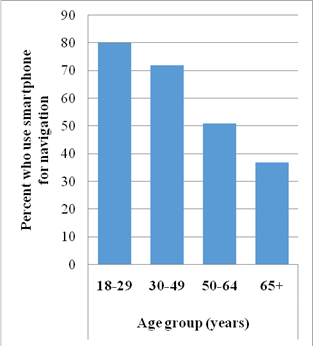
Concept explainers
a.
To describe what the graph reveals about the relationship between age group and use of smartphones for navigation.
a.
Answer to Problem 35E
The age group that is most likely to use smartphone for navigation are the 18 to 29 year olds.
The age group that is least likely to use smartphone for navigation are the 65+ year olds.
The majority of the 18 to 64 year olds appear to use smartphones for navigation.
The majority of the 65+ year olds appear to not use smartphones for navigation.
Explanation of Solution
Given the bar graph below that displays data on the percentage of smartphone owners in several age groups who say that they use their phone for turn-by-turn navigation.

The age group that is most likely to use smartphone for navigation are the 18 to 29 year olds, because the highest bar in the bar graph corresponds to the category "18-29".
The age group that is least likely to use smartphone for navigation are the 65+ year olds, because the lowest bar in the bar graph corresponds to the category "65+".
The majority of the 18 to 64 year olds appear to use smartphones for navigation, because each of the bars corresponding to these categories have a height of at least 50.
The majority of the 65+ year olds appear to not use smartphones for navigation, because the bar corresponding to this age category has a height that is less than 50.
b.
To find out and explain would it be appropriate to make a pie chart of the data given.
b.
Answer to Problem 35E
Not appropriate to make a pie chart of the data given.
Explanation of Solution
In the bar graph, we note that approximately 80% of the 18-29 year olds, 72% of the 30-49 year olds, 51% of the 50-64 year olds and 37 % of the 65+ year old use smartphones for navigation.
If we would then add all these percentages, then we would obtain more than 100% and thus it won't be appropriate to construct a pie chart.
Moreover, you can also notice that a pie chart is not appropriate due to the different bars not representing a part of the same whole (as each age category is considered separately).
Chapter 1 Solutions
PRACTICE OF STATISTICS F/AP EXAM
Additional Math Textbook Solutions
Elementary Statistics (13th Edition)
Introductory Statistics
A Problem Solving Approach To Mathematics For Elementary School Teachers (13th Edition)
College Algebra (7th Edition)
Algebra and Trigonometry (6th Edition)
Thinking Mathematically (6th Edition)
- Find the critical value for a left-tailed test using the F distribution with a 0.025, degrees of freedom in the numerator=12, and degrees of freedom in the denominator = 50. A portion of the table of critical values of the F-distribution is provided. Click the icon to view the partial table of critical values of the F-distribution. What is the critical value? (Round to two decimal places as needed.)arrow_forwardA retail store manager claims that the average daily sales of the store are $1,500. You aim to test whether the actual average daily sales differ significantly from this claimed value. You can provide your answer by inserting a text box and the answer must include: Null hypothesis, Alternative hypothesis, Show answer (output table/summary table), and Conclusion based on the P value. Showing the calculation is a must. If calculation is missing,so please provide a step by step on the answers Numerical answers in the yellow cellsarrow_forwardShow all workarrow_forward
- Show all workarrow_forwardplease find the answers for the yellows boxes using the information and the picture belowarrow_forwardA marketing agency wants to determine whether different advertising platforms generate significantly different levels of customer engagement. The agency measures the average number of daily clicks on ads for three platforms: Social Media, Search Engines, and Email Campaigns. The agency collects data on daily clicks for each platform over a 10-day period and wants to test whether there is a statistically significant difference in the mean number of daily clicks among these platforms. Conduct ANOVA test. You can provide your answer by inserting a text box and the answer must include: also please provide a step by on getting the answers in excel Null hypothesis, Alternative hypothesis, Show answer (output table/summary table), and Conclusion based on the P value.arrow_forward
 MATLAB: An Introduction with ApplicationsStatisticsISBN:9781119256830Author:Amos GilatPublisher:John Wiley & Sons Inc
MATLAB: An Introduction with ApplicationsStatisticsISBN:9781119256830Author:Amos GilatPublisher:John Wiley & Sons Inc Probability and Statistics for Engineering and th...StatisticsISBN:9781305251809Author:Jay L. DevorePublisher:Cengage Learning
Probability and Statistics for Engineering and th...StatisticsISBN:9781305251809Author:Jay L. DevorePublisher:Cengage Learning Statistics for The Behavioral Sciences (MindTap C...StatisticsISBN:9781305504912Author:Frederick J Gravetter, Larry B. WallnauPublisher:Cengage Learning
Statistics for The Behavioral Sciences (MindTap C...StatisticsISBN:9781305504912Author:Frederick J Gravetter, Larry B. WallnauPublisher:Cengage Learning Elementary Statistics: Picturing the World (7th E...StatisticsISBN:9780134683416Author:Ron Larson, Betsy FarberPublisher:PEARSON
Elementary Statistics: Picturing the World (7th E...StatisticsISBN:9780134683416Author:Ron Larson, Betsy FarberPublisher:PEARSON The Basic Practice of StatisticsStatisticsISBN:9781319042578Author:David S. Moore, William I. Notz, Michael A. FlignerPublisher:W. H. Freeman
The Basic Practice of StatisticsStatisticsISBN:9781319042578Author:David S. Moore, William I. Notz, Michael A. FlignerPublisher:W. H. Freeman Introduction to the Practice of StatisticsStatisticsISBN:9781319013387Author:David S. Moore, George P. McCabe, Bruce A. CraigPublisher:W. H. Freeman
Introduction to the Practice of StatisticsStatisticsISBN:9781319013387Author:David S. Moore, George P. McCabe, Bruce A. CraigPublisher:W. H. Freeman





